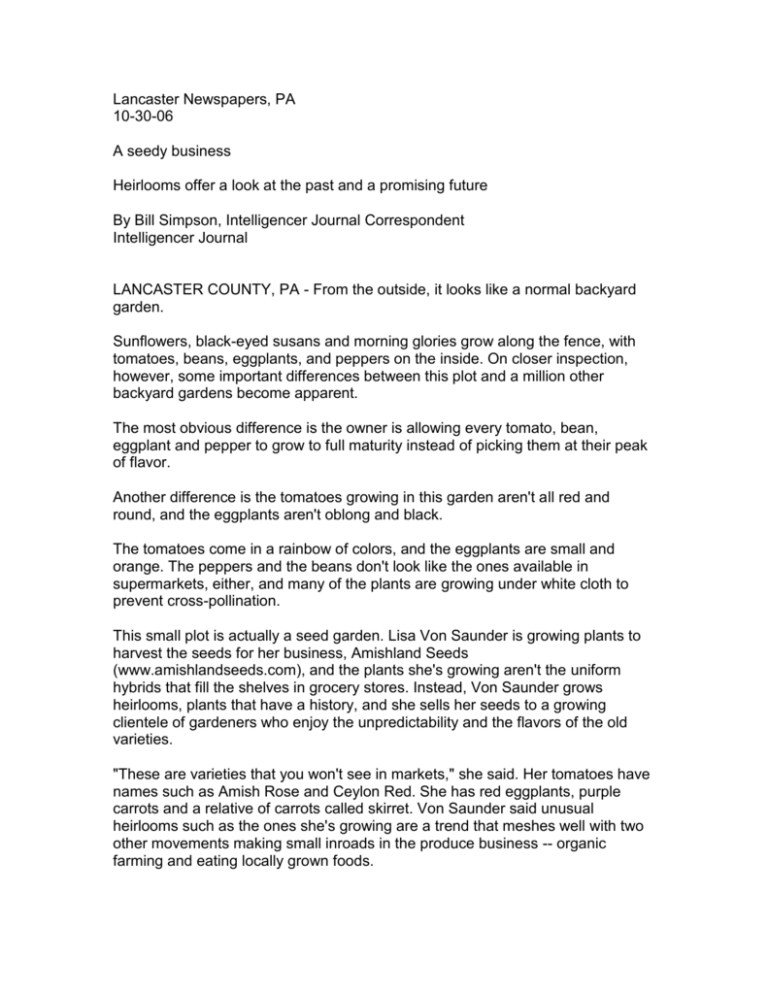seedybusiness - Iowa State University
advertisement

Lancaster Newspapers, PA 10-30-06 A seedy business Heirlooms offer a look at the past and a promising future By Bill Simpson, Intelligencer Journal Correspondent Intelligencer Journal LANCASTER COUNTY, PA - From the outside, it looks like a normal backyard garden. Sunflowers, black-eyed susans and morning glories grow along the fence, with tomatoes, beans, eggplants, and peppers on the inside. On closer inspection, however, some important differences between this plot and a million other backyard gardens become apparent. The most obvious difference is the owner is allowing every tomato, bean, eggplant and pepper to grow to full maturity instead of picking them at their peak of flavor. Another difference is the tomatoes growing in this garden aren't all red and round, and the eggplants aren't oblong and black. The tomatoes come in a rainbow of colors, and the eggplants are small and orange. The peppers and the beans don't look like the ones available in supermarkets, either, and many of the plants are growing under white cloth to prevent cross-pollination. This small plot is actually a seed garden. Lisa Von Saunder is growing plants to harvest the seeds for her business, Amishland Seeds (www.amishlandseeds.com), and the plants she's growing aren't the uniform hybrids that fill the shelves in grocery stores. Instead, Von Saunder grows heirlooms, plants that have a history, and she sells her seeds to a growing clientele of gardeners who enjoy the unpredictability and the flavors of the old varieties. "These are varieties that you won't see in markets," she said. Her tomatoes have names such as Amish Rose and Ceylon Red. She has red eggplants, purple carrots and a relative of carrots called skirret. Von Saunder said unusual heirlooms such as the ones she's growing are a trend that meshes well with two other movements making small inroads in the produce business -- organic farming and eating locally grown foods. Von Saunder said she sells several thousand packets of seeds a year at $2.50 apiece, but "I'm one of the small people." "It's for love," she said of her interest in heirlooms, which is something she began to develop about 10 years ago. A visit to Monticello was her inspiration. "I couldn't get any seeds from Thomas Jefferson's era," she said. So she began to study and search and eventually got into the heirloom seed business. She's developed a network of fellow seed savers that stretches from Idaho and Louisiana to Ukraine, and through her connections, she's able to offer seeds few other sellers have, such as a tomato called speckled Siberian. She believes she's the only source for that tomato in the United States, and she sees increasing interest in heirloom plants. "It's grown exponentially in the last 10 years," she said. Long before that, the Heirloom Seed Project at Landis Valley Farm Museum (www.landisvalleymuseum.org/...) was working to preserve old varieties. The project began in 1985, making it one of the earliest in the country, and at Landis Valley, the focus is narrow. All the plants that grow in the Heirloom Seed Project's gardens are varieties the Pennsylvania Germans grew from 1750 to 1940. Many of those varieties have names with a distinct Lancaster County sound, such as Amish paste tomato, Grandma Hershey's sugar peas, Pennsylvania German red lima beans, and Lancaster sure crop corn. Joe Schott, farm and garden manager at Landis Valley, sees strong opportunities in heirloom seeds and plants. "People can make a business of heirloom seeds," he said. "You can create a market niche for color or flavor. It's becoming a trend for restaurants." Schott said Landis Valley sells its seeds to buyers in all 50 states and that one reason people like to grow heirlooms is they don't know exactly what they'll get. "It's a little bit of a mystery," he said. That means most heirlooms are "indeterminate," a description that indicates the plants will grow to varying heights and mature at varying times. What isn't a mystery is the primary reason gardeners grow heirlooms. "Heirlooms taste good," said Von Saunder, and they taste good because they grow locally. Produce in supermarkets typically travels hundreds or thousands of miles to its destination. A report prepared by the Leopold Center for Sustainable Agriculture at Iowa State University found that most food in the United States travels between 1,500 and 2,000 miles before reaching the consumer. Lancaster County is a large producer of produce, but in August, local supermarkets were selling tomatoes that had traveled from Mexico and Canada and melons that had come from California. Von Saunder said those items would be distinct underdogs in a flavor contest with Lancaster County produce. "If you want it fresh, stay away from the grocery store," said Chris Powell, owner of Good Harvest Farm in Strasburg. Powell grows about 30 acres of vegetables and fruits and sells most of what he grows at the Lancaster County Farmers Market in Wayne. Heirlooms are a small part of his production, but they reach an eager audience along the Main Line. "They generate a lot of interest," he said of his heirlooms. He started growing them when one customer requested them, and now they make up about 5 percent of his total yield. Powell said that, compared to hybrids, heirlooms have some real drawbacks. Frequently, heirlooms have relatively low yields, and they don't travel well. So they carry higher price tags, but many customers gladly pay them. "We had to educate customers," Powell said, but now the heirlooms are a nice niche business for him. "Freshness can be a niche," Powell said, and he's always looking a year or two ahead for the next trend. One that he sees on the horizon is micro greens, and he growing them. "We sell tons of lettuce in Wayne," he said. In Lancaster County, buyers looking for heirloom tomatoes and other vegetables might have to look rather hard. At Central Market, Ethel and John Stoner sell some heirloom vegetables, and they're slowly developing a following. "People love the taste," Ethel Stoner said. "Last year was our first, and some people took until the end of summer to try the tomatoes." One sales barrier is their appearance. "Some people still expect a perfect tomato," she said, but her Cherokee Purple tomatoes are actually close to black in color. Brandywine tomatoes weigh a pound or more, and their thin skins mean they don't travel well. Romanesco cauliflower has a cone shape, and it's lime green, not white. For a consumer whose only exposure to produce has come through the uniform hybrid varieties found in supermarkets, heirlooms can look quite strange. "Appearance doesn't mean taste," Stoner said, and her best marketing tool is simply to give interested customers an heirloom to take home and sample. The result is that many come back, willing to pay a little more for the flavors of the heirlooms. An old axiom says everything old becomes new again. Heirloom plants were around long before scientists thought about crossing genes, and now heirlooms are making a comeback. For growers, they offer business opportunities, and for consumers they offer intriguing flavors and the fun of growing plants that don't conform to the popular perception of how a tomato or an eggplant should look. For consumers apprehensive about eating black tomatoes or orange eggplants, Lisa Von Saunder has this simple bit of advice: "Do a taste test."







